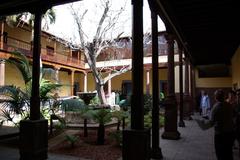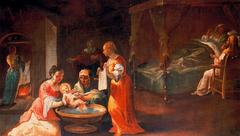Lercaro Palace: Visiting Hours, Tickets, and a Guide to San Cristóbal de La Laguna’s Historical Heritage
Date: 03/07/2025
Introduction: The Significance of Lercaro Palace
Lercaro Palace (Casa Lercaro) is a cornerstone of the historic city of San Cristóbal de La Laguna, Tenerife. Recognized as a premier example of Renaissance and Canarian architecture, this stately residence embodies the unique cultural and architectural blending that defines the Canary Islands. Built in 1593 by the Genoese Lercaro merchant family, the palace’s grand facade, intricately carved wooden galleries, and volcanic stonework showcase both Mediterranean influence and local craftsmanship. Today, the palace stands as a symbol of La Laguna’s cosmopolitan past and its enduring status as a UNESCO World Heritage Site (Web Tenerife; Patrimonio Mundial Ayuntamiento de La Laguna).
Currently, Casa Lercaro houses the Museum of History and Anthropology of Tenerife (MHAT), which offers a deep dive into the island’s evolution—from its indigenous Guanche roots, through Spanish colonization, to modern society. The museum’s exhibitions, set within the palace’s preserved Renaissance interiors, allow visitors to connect with centuries of local history (Spain.info; WhichMuseum).
This guide details everything you need to plan your visit: opening hours, ticket options, guided tours, accessibility, and highlights of both the palace’s architecture and its storied past—including the legendary tale of Catalina Lercaro. Whether you are passionate about history, intrigued by architecture, or eager to explore Canarian culture, this article equips you for a memorable visit (Go Tenerife).
For current information on visiting hours, ticketing, and special events, always consult the museum’s official resources or trusted tourism portals (Museum of History and Anthropology of Tenerife).
Table of Contents
- Lercaro Palace: Origins, Construction, and Evolution
- The Lercaro Family, Legends, and the Haunted Tale of Catalina
- Museum of History and Anthropology of Tenerife (MHAT): Exhibitions and Visitor Experience
- Architectural Highlights: Renaissance and Canarian Fusion
- Practical Visitor Information: Hours, Tickets, Accessibility, and Tips
- Nearby Attractions in San Cristóbal de La Laguna
- Frequently Asked Questions (FAQ)
- Summary and Resources
Lercaro Palace: Origins, Construction, and Evolution
Historical Foundation
The Lercaro Palace was commissioned in 1593 by Francisco Lercaro de León, a leading figure in the Lercaro family, who migrated from Genoa and quickly established themselves as influential merchants in Tenerife (webtenerife.co.uk). Situated on Calle de San Agustín, the palace’s location and ornate construction underscored the family’s wealth and prominence. Combining Renaissance symmetry with Canarian traditions, the palace’s stonework, wooden porticos, and central patio exemplify the architectural sophistication of the era (tenerifebyrocio.com).
Architectural Preservation and Transformation
Throughout the centuries, Lercaro Palace has seen structural adaptations reflecting evolving tastes and functions: from private residence to university classrooms, primary school, commercial spaces, and, since 1993, the Museum of History and Anthropology (Web Tenerife). Careful restoration has preserved its Renaissance character, especially the central courtyard and the iconic stone staircase (Patrimonio Mundial Ayuntamiento de La Laguna).
The Lercaro Family, Legends, and the Haunted Tale of Catalina
The Lercaros were instrumental in shaping La Laguna’s social and economic landscape in the 16th and 17th centuries. Their influence extended well beyond commerce, introducing Mediterranean customs to the islands. The legend of Catalina Lercaro, said to have tragically ended her life to avoid an unwanted marriage, infuses the palace with a layer of mystery and intrigue. Reports of ghostly sightings continue to attract visitors fascinated by the supernatural side of Canarian heritage (tenerifebyrocio.com).
Museum of History and Anthropology of Tenerife (MHAT): Exhibitions and Visitor Experience
Permanent Exhibitions
MHAT at Casa Lercaro offers a chronological journey through Tenerife’s past:
- Pre-Hispanic Guanche Culture: Artifacts and models explore the island’s indigenous roots.
- Conquest and Colonial Society: Exhibits chart the Spanish conquest and La Laguna’s emergence as a colonial capital.
- Economic and Social Development: Displays highlight agriculture, trade, and the merchant class.
- Modernization: Photographs, documents, and objects trace the island’s transformation into the 20th century.
Collections include period furniture, historical documents, ceramics, clothing, and ethnographic items (Spain.info; WhichMuseum).
Temporary Exhibitions and Activities
The museum regularly hosts temporary exhibitions, workshops, lectures, and cultural events. Check the official website for current programming (WhichMuseum).
Architectural Highlights: Renaissance and Canarian Fusion
Exterior and Facade
The Lercaro Palace is renowned for its Renaissance-inspired stonework, symmetrical window placement, and painted ornamentation—a rare feature in Canarian architecture (visitcanaryislands.org). The main entrance, crafted in Genoese Mannerist style, is adorned with the Lercaro family crest and heraldic motifs (patrimoniomundial.aytolalaguna.es).
Interior and Courtyard
Visitors enter through a grand zaguán leading to the iconic stone staircase and the central patio, surrounded by wooden galleries supported by stone and wood columns. The upper galleries feature finely carved wooden panels with vegetal and heraldic motifs. The palace’s artesonado ceilings and period furnishings further exemplify Renaissance and Canarian synthesis (hellocanaryislands.com).
Preservation and Recognition
Declared a Bien de Interés Cultural (Asset of Cultural Interest) in 2008, Lercaro Palace is protected for its architectural and historical value (turismo.aytolalaguna.es). Its integration into La Laguna’s UNESCO-listed historic center underscores its significance in Atlantic and Canarian heritage (museosdetenerife.org).
Practical Visitor Information: Hours, Tickets, Accessibility, and Tips
Location
Address: Calle San Agustín, 22, San Cristóbal de La Laguna, Tenerife
Opening Hours
- Tuesday to Saturday: 10:00 AM – 6:00 PM
- Sunday and Holidays: 10:00 AM – 3:00 PM
- Closed: Mondays
Check the official website for updates, as hours may vary for special events or holidays.
Tickets
- General Admission: €4.00
- Concessions (students, seniors, groups of 8+): €3.50 per person
- Free Entry: Fridays and Saturdays from 4:00 PM until closing, and on select cultural days
- Group Visits: Advance booking required for groups of 10–30 people (WhichMuseum)
Accessibility
While the museum offers ramps and staff assistance, some areas may be less accessible due to the historic structure. Contact the museum in advance if you have specific needs.
Language and Interpretation
Exhibits are primarily in Spanish with some English translations. Guided tours in English may be available upon request; it is advisable to inquire or bring a translation app.
Facilities
Restrooms and a visitor information desk are available. There is no on-site café, but local dining options are abundant nearby.
Photography
Photography without flash is generally permitted. The central courtyard and wooden balconies are particularly photogenic.
Nearby Attractions in San Cristóbal de La Laguna
- Cathedral of La Laguna
- Church of Nuestra Señora de la Concepción
- Museum of Science and the Cosmos
- Santa Clara Museum of Sacred Art
- Casa Museo de Los Sabandeños
The surrounding historic center, with its cobbled streets and colonial mansions, is ideal for further exploration (Guide to Canary Islands).
Frequently Asked Questions (FAQ)
Q: What are the Lercaro Palace visiting hours?
A: Tuesday to Saturday, 10:00 AM – 6:00 PM; Sundays and holidays, 10:00 AM – 3:00 PM; closed on Mondays.
Q: How much are tickets?
A: €4.00 for individuals; €3.50 for concessions and groups; free on Fridays and Saturdays from 4:00 PM.
Q: Is the museum accessible for visitors with reduced mobility?
A: Ramps and staff assistance are available, but some areas may be challenging. Contact the museum for details.
Q: Are guided tours available in English?
A: Some tours are available in English upon request; inquire ahead for availability.
Q: What are the best times to visit?
A: Weekday mornings are less crowded. Free admission hours on Friday and Saturday evenings are popular.
Summary: Why Visit Lercaro Palace?
Lercaro Palace is a vibrant testament to Tenerife’s layered history and architectural grandeur. Its transformation from an elite residence to the Museum of History and Anthropology of Tenerife exemplifies the successful preservation and adaptive reuse of cultural landmarks. Visitors are treated to evocative courtyards, compelling exhibitions, and a palpable sense of the island’s evolving identity—from Guanche origins to modern times (Patrimonio Mundial Ayuntamiento de La Laguna; Web Tenerife).
Practical amenities, affordable ticketing, and guided tours make it accessible to a wide audience, including those with mobility challenges. Its location within a UNESCO World Heritage Site enhances the experience, offering seamless access to La Laguna’s other cultural treasures (Spain.info; WhichMuseum).
To maximize your visit, consider using the Audiala app for interactive guides and maps, and stay updated on special exhibitions via official channels (Go Tenerife).
Sources and Official Links
- This article draws on detailed information from the following resources:

